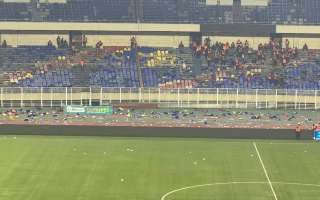Stade des Martyrs
| Capacity | 80 000 |
|---|---|
| Country | Democratic Republic of the Congo |
| City | Kinshasa |
| Clubs | - |
| Full name | Stade des Martyrs de la Pentecôte |
| Other names | Stade Kamanyola (1994–1997) |
| Inauguration | 04/09/1994 |
| Construction | 1988–1993 |
| Cost | $38 M |
Advertisement
Stade des Martyrs – stadium description
How can Stade des Martyrs be briefly described?
Stade des Martyrs serves as the national stadium of the Democratic Republic of the Congo and is one of the largest stadiums in Africa. The venue was built between 1988 and 1993 with the support of China. It features an athletics track surrounded by an oval ring of tall reinforced-concrete stands, with a capacity of 80,000 spectators.
The stadium hosts matches of the national team, is used by local clubs, and serves as a venue for concerts and other events. In 2023, Pope Francis visited the stadium, and it also hosted the Francophone Games the same year.
The stadium was originally named to honor the military achievements of the country’s dictator, Mobutu, but after he was overthrown in 1997, it was renamed to honor the victims of his regime. The stadium is located near the parliament building in Kinshasa, and a large indoor arena with a capacity of 20,000 spectators is planned nearby.
How was Stade des Martyrs built?
The construction of a large stadium in Kinshasa, the capital of the Democratic Republic of the Congo (known as Zaire until 1997) and one of Africa’s largest urban areas, was supported by the Chinese government, with a memorandum signed on May 13, 1987.
Work officially began on October 14, 1988, and construction was completed exactly five years later, on October 14, 1993. The choice of this date was not accidental, as it coincided with the birthday of Zaire’s then-president, Mobutu Sese Seko. The construction cost amounted to 38 million US dollars.
The stadium’s opening had to wait almost a year after construction was finished – it was inaugurated on September 4, 1994, during an African Cup of Nations qualifying match between Zaire and Malawi (1–1).
What does Stade des Martyrs look like?
The stadium has an oval shape, with two-tiered stands forming a massive ring around the athletics track. A moat separates the stands from the track and the pitch. Only the upper sections of the stands are covered, with the roof extending slightly further along the sidelines.
The venue has a capacity of 80,000, making it by far the largest stadium in the country and also one of the largest in Africa. After renovations carried out ahead of the 2023 Francophone Games, the stands are now fully equipped with plastic seating.
The stadium’s surroundings include a training pitch with a running track and small indoor sports halls. In 2023, construction began next door on a large multi-purpose indoor arena (Kinshasa Arena) with 20,000 seats, scheduled for completion in 2026. The stadium is located near the parliament building of the Democratic Republic of the Congo.
What role does Stade des Martyrs play?
The stadium is the largest and most important in the Democratic Republic of the Congo and effectively serves as the national stadium. The country’s national team regularly plays its matches here, and local clubs also use the facility.
It is also a venue for music concerts, political rallies, and other events. On February 2, 2023, Pope Francis visited the stadium, and in the summer of 2023 it served as the main venue of the 9th Francophone Games. Kinshasa is also set to host the 15th African Games in 2031.
Several tragedies caused by overcrowding have occurred at Stade des Martyrs. For example, on October 22, 2022, during a concert by Fally Ipupa that attracted 120,000 spectators, 11 people lost their lives.
Until the opening of Stade des Martyrs, the country’s most important stadium was Stade Tata Raphaël, located less than 2 km away.
What does the name Stade des Martyrs refer to?
The stadium was originally named Stade Kamanyola, after a town near the country’s eastern border where the forces of the future president Mobutu won a battle against the Simba rebels in 1964.
Mobutu became president in 1965. He was known for establishing dictatorial rule and for changing the country’s name to Zaire in 1971. The stadium was built during his rule, and its original name highlighted the military achievements of the leader, making the venue one of the symbols of his regime.
In 1997, as a result of a rebellion, Mobutu left the country, bringing his rule to an end. At that time, the decision was made to break with the legacy of the former dictator, and the stadium was renamed Stade des Martyrs (full name: Stade des Martyrs de la Pentecôte – Stadium of the Martyrs of Pentecost).
The new name honors four politicians, including the country’s former prime minister Évariste Kimba, as well as Jérôme Anany, Emmanuel Bamba, and Alexandre Mahamba, who were executed at the beginning of Mobutu’s rule on June 2, 1966, during Pentecost, under the accusation of a supposed conspiracy.
The execution was a public display and was seen as an attempt to intimidate political opponents and consolidate Mobutu’s power.
Advertisement
Pictures
-
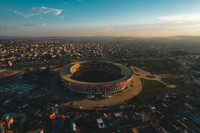
14.10.2024 © OtikolenoiL 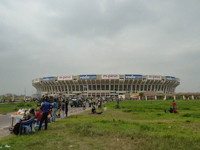
16.06.2013 © Frank Jasperneite 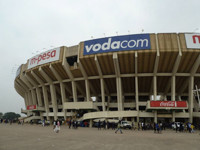
16.06.2013 © Frank Jasperneite 
16.06.2013 © Frank Jasperneite 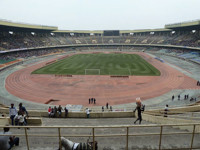
16.06.2013 © Frank Jasperneite 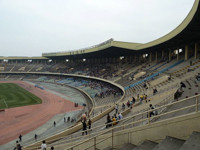
16.06.2013 © Frank Jasperneite 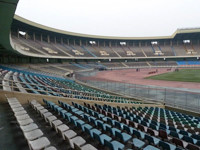
16.06.2013 © Frank Jasperneite 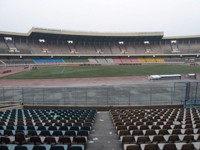
16.06.2013 © Frank Jasperneite 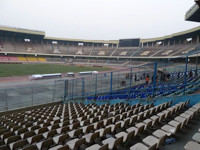
16.06.2013 © Frank Jasperneite 
16.06.2013 © Frank Jasperneite 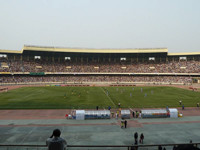
16.06.2013 © Frank Jasperneite 
16.06.2013 © Frank Jasperneite

 StadiumDB
StadiumDB